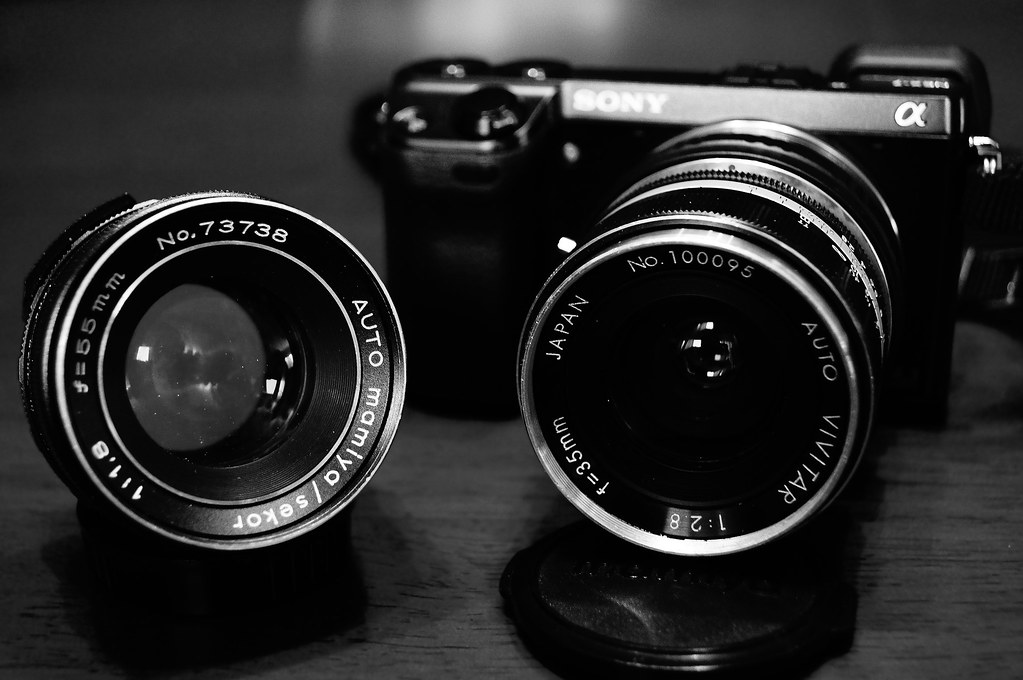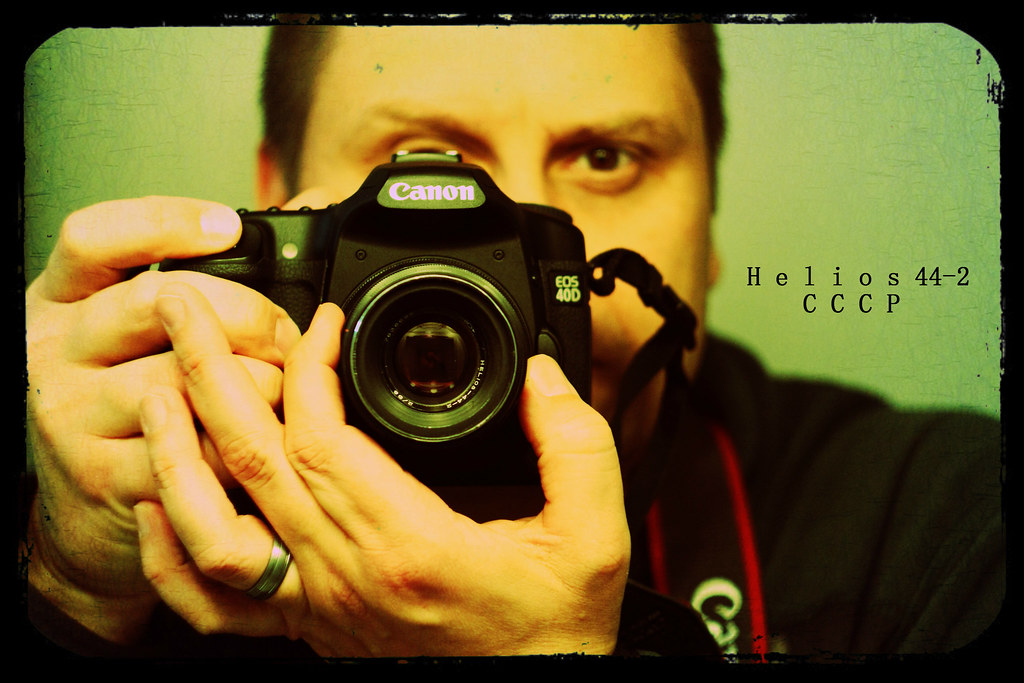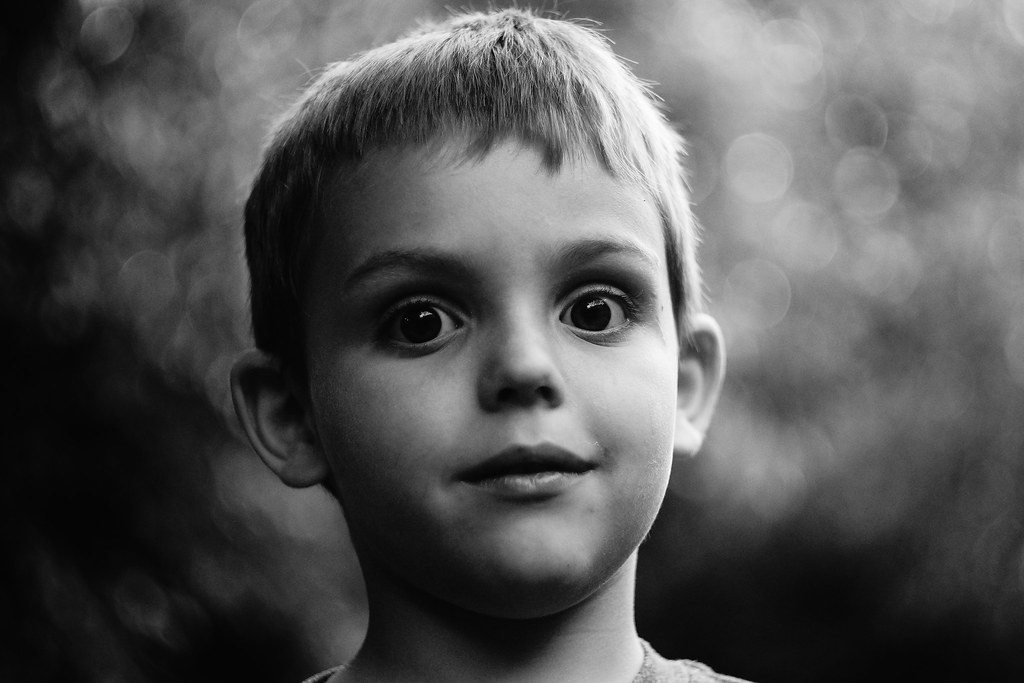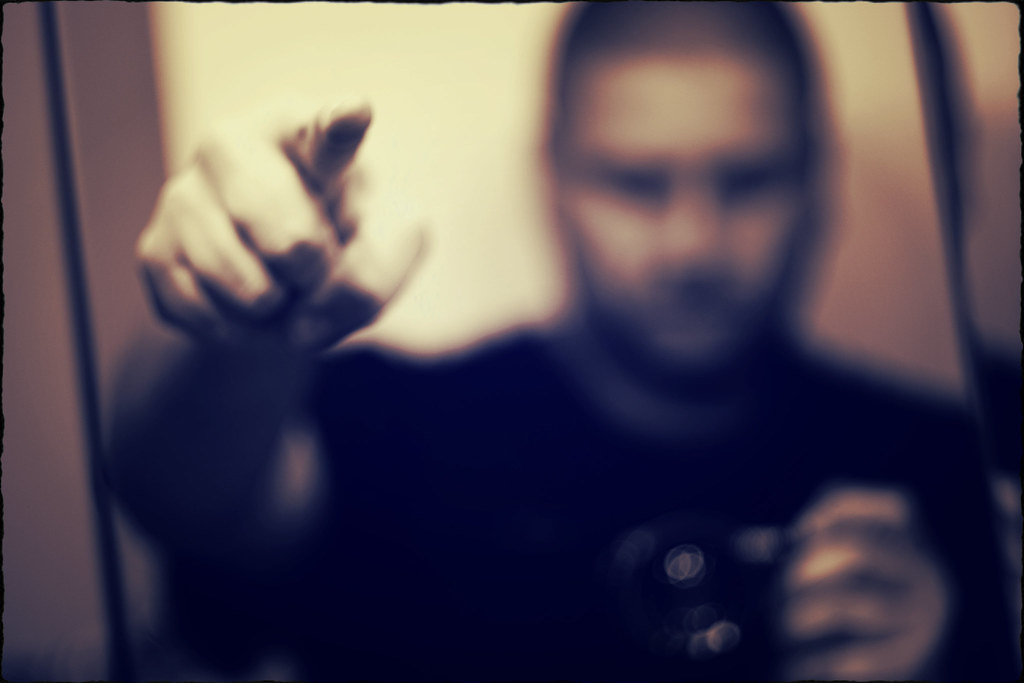There are many reasons why people still use these old film relics in the brave new digital world. Mainly because they are still capable of taking amazing photographs. If you think about it, these lenses were responsible for the majority of the most incredible photographs of the Twentieth Century. But there is also the issue of cost. Many times old lenses are available for a fraction of what its modern, plastic auto focus version would cost. Although for some lenses, especially for very high quality glass of exceedingly rare or esoteric value, this is not the case. Many old lenses still sell for thousands and thousands of dollars.
Old M42 lenses on a NEX 7
Another compelling reason (and this is a big one for me) is the feeling you get when you use them. Of course its important to point out that a lens is nothing more then a tool used to capture the image you are after, and the image is everything. But I find that I enjoy using a heavy, all metal lens full with high quality glass and coatings to help me capture that image. Actually turning a metal aperture ring by hand instead of clicking some small plastic dial on a plasticky camera body is more of a Zen like experience. I feel that I can connect with my gear in this way which in turns helps bring me to that place where my mind is most focused on trying to capture light and bend it to my will. Photography is an artistic process, and anything that stimulates your mind and helps bring you to that creative plane should be exploited.
So without further ado here are some of the more basic technical issues you should think about if you are considering the use of old film era lenses. Future posts on this blog will cover more in depth looks at some of the old lens lines and their differences and availability.
Probably the most important aspect in understanding exactly which old lens can be used on which camera is flange to focal distance. Sounds technical and possibly confusing but all it means is the original distance that a manufacturer of an old camera and lens system required for the rear of the lens to be placed away from the film plane. In other words, the distance from where the actual film was in the camera out to the mounting flange on the front of the camera where the lens would be connected. This distance will determine if a lens can easily be adapted to your camera, as long as someone makes an adapter for it that is.
Basically, if the original FtF distance on the lens you have is greater then the FtF distance of the camera you are trying to mount it to then theoretically it should work. I should point out here for clarification that individual lenses in a system generally will all have the same FtF distance. For example, all Canon FD lenses have the same FtF distance so you only need to buy one Canon FD adapter for your camera and all those lenses should work. You dont have to figure out the FtF for each lens. (Note: there are a few small exceptions to this rule. Some lens lines have a few specialty lenses that were designed to be used in mirror lock up mode on their old original bodies and these may not work with a basic adapter. But these lenses are few and far between and usually very expensive).
Are old lenses worth it? Oh yeah.
Minolta MD 35/2.8
Here is a good link to the Wiki page for a FtF distance list for most camera systems.
http://en.wikipedia.org/wiki/Flange_focal_distance
The easiest way to use this list is to first find your camera system and where it falls on the list. Then look at everything listed under your camera. Those are these systems that have a greater FtF distance so (again, theoretically) they should be able to be adapted to your camera.
Another thing the list will show you is one of the main differences in modern camera design. For a long time the DSLR (Digital Single Lens Reflex) was the predominant type of camera used by professional photographers and advanced enthusiasts. This type of camera has a large mirror in front of the shutter to bounce light up to the view finder so the image can be seen by the shooter. Most Canon and Nikon cameras fall into this category. Recently however a paradigm shift has been occurring with the introduction of Mirrorless cameras. These cameras do away with the bulky mirror box assembly and use an electronic view finder instead of an optical one. This frees up a lot of space in front of the shutter/sensor area so the mounting flange for the lens can be moved much closer to the sensor.
Just look at the FtF distances on that list for some of the major camera system. You will see that the Canon EOS EF mount system has a FtF distance of 44mm. That places it pretty far down the list, with only a few major systems listed below it that can be adapted. Conversely the Sony E mount system (used on NEX and the new A7 cameras) is very close to the top with a FtF distance of only 18mm. With such a short FtF distance the Sony system is able to adapt many more lenses to their bodies then the Canon system can.
Helios on my EOS. M42 Russian goodness.
So what type of camera you have will in large part determine the availability of legacy glass that will be easily adaptable to your camera. For instance, Nikon is way down on the bottom with little or no options to shoot for legacy glass other then Nikons own legacy manual lenses in the F mount. (Note: There is a way to use lenses listed above your camera on this list, but it involves the use of an extra piece of 'correction glass' in the adapter and I do not recommend doing this. If you want to go thru all the trouble of using these quality old lenses then dont put some cheap, coke bottle glass in your adapter that will degrade image quality.)
Another major difference in using either a DSLR or Mirrorless camera is the aforementioned view finder. When using the optical view finder (OVF) on a DSLR there is no compensation to the image you see when you stop down the aperture on your old lens. So the OVF just gets darker and darker until its really to dark to focus properly or even compose. Many people get around this by focusing while the lens is wide open and then stopping down to take the picture. A bit of a bulky and cumbersome work around but it does work.
With a Mirrorless camera and an electronic view finder (EVF) you basically are just looking into a tiny TV screen when you use the view finder. The advantages of this is that as you stop the lens down and less light is entering the lens the EVF doesn not get darker. The camera will compensate for the loss of light and make the image brighter while still remaining true to what the final image will look like. This is a huge boon to legacy shooters. Many Mirrorless cameras also have some form of Focus Peaking which simply has to be used to be appreciated. What focus peaking does is highlight in a chosen color what area of the image is in focus as you rack the lens back and forth. This is an incredible advantage to users of legacy lenses and makes old lenses almost as fast to use as auto focus lenses in just about any situation except for fast action or sports.
Zeiss Biotar 58/2, M42 mount
on NEX 7
After you figure out which lenses you can use on whichever camera you have you are pretty much ready to start looking for these little gems and can begin cranking out great photos. One of the joys of using old lenses is that you can find them in all kinds of places. Thrift stores, garage sales, flea markets...you just never know what is going to turn up. Sometimes the hunt for these lenses becomes fun in and of itself. There are of course the 'usual' places to find them, like the auction site and the place that Craig runs. But many of the lenses found here will carry a higher premium since those sellers are generally more knowledgeable then most thrift store pricing schemes (although I have noticed this changing as well, thrift stores are starting to wise up). The simple fact is that more and more people are discovering or re-discovering the ability of these old lenses and that they are fully capable of taking photos just as good as today's plasticky zooms.
Using manual focus lenses can be a wonderful photographic journey that can lead you to view your photography in new and different ways while stimulating your creativity. If you are contemplating giving it a try I say go for it. Dont be afraid to give up Auto Focus, dont be afraid to try something different. The more I shoot the more I realize photography is very much like life in that it is a never ending journey of discovery. There is always another technique or tool to use and the learning never ends. Old film glass can be a powerful tool in your arsenal of image creation. Give em a chance.
Minolta MD Rokkor-X 50/1.7









